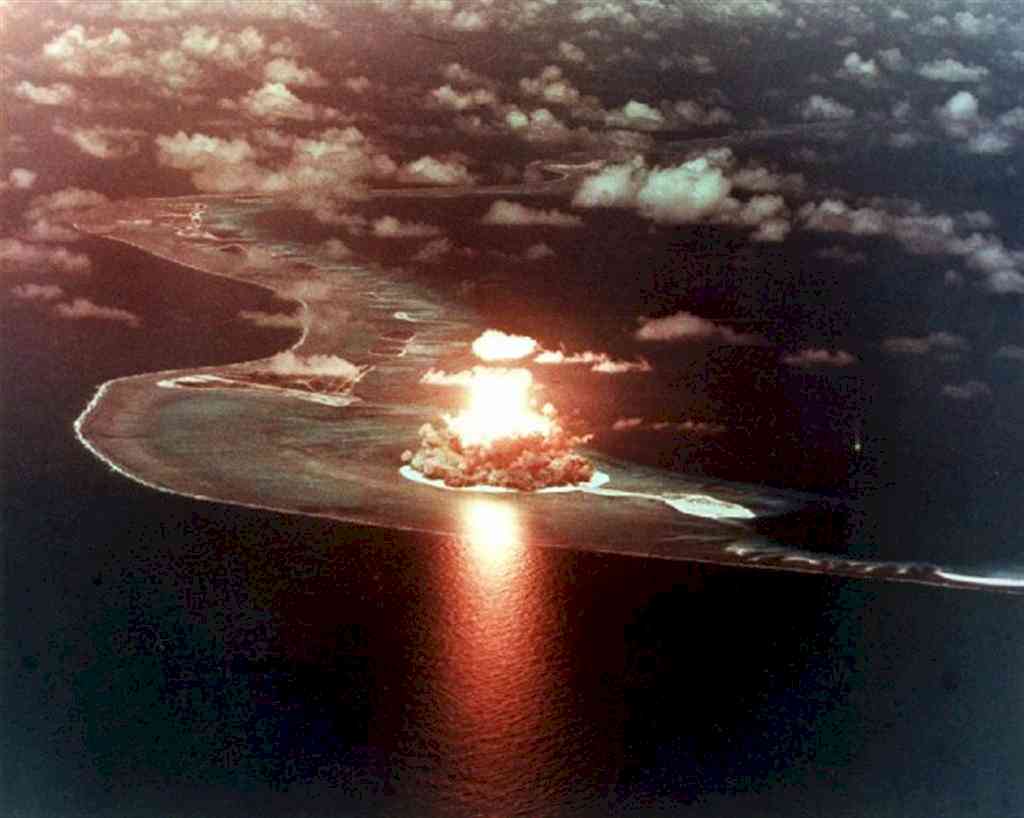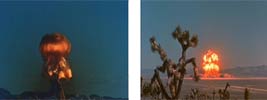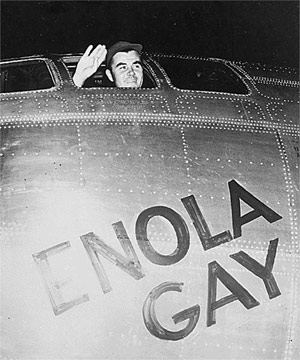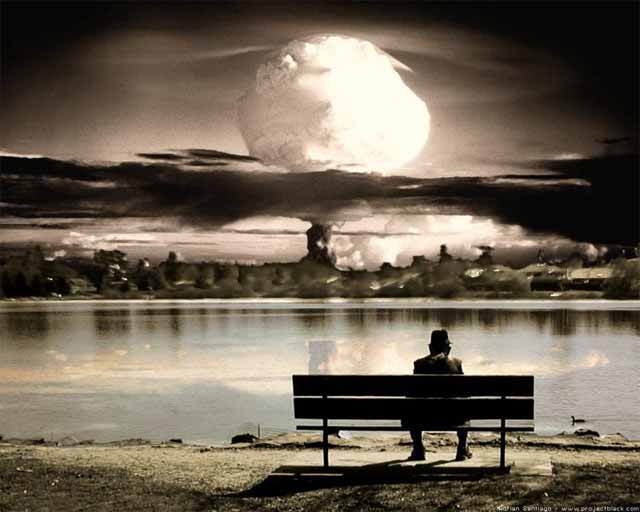Overpowering
Swift Or Not - Still DeadlyThe energy produced by the breaking down of the atom is a very poor kind of thing. - Ernest Rutherford Instead of trying to build newer and bigger weapons of destruction, - Deep Thoughts by Jack Handey I've never seen a nuclear test except on film (thank goodness!) but I've been in or near a few powerful weather events including a tornado, two hurricanes, a few close lightning strikes and some storms at sea. I've encountered giant waves and been in the usual moderate earthquakes. We've toured several dams, going down near the massive turbines where the very air hums with energy. I've stood under high-voltage cross-country power lines and felt my hair stand on end while looking up underneath the towering pylons. I love processes of great power. I find them frightening but exhilarating. Perhaps that's human nature. A person whose intellect and creativity I admired very much, Richard Feynman, viewed a nuclear test (indeed, he was a key player in the bomb's development). He died early of a rare cancer often caused by radiation. His experience was thrilling nonetheless.
Kiwi Nuke Vets Less Healthy
New Zealand nuclear test veterans and their offspring are markedly less healthy than their relatives, research shows. About 550 men served on New Zealand frigates Pukaki and Rotoiti during British nuclear tests near the Malden and Christmas Islands in the mid-Pacific in 1957 and 1958. A study involving 110 veterans and 2000 of their blood relatives reveals that apart from a variety of cancers, the veterans suffer a range of symptoms consistent with a syndrome called synovitis acne pistulosis hyperostosis andosteitis. This was reflected in skin, skeletal, arthritic, respiratory, cardiovascular and blood disorders of the veterans' offspring. New Zealand Nuclear Test Veterans Association spokeswoman Ruth McKenzie said health issues were glaringly obvious once comparisons were made between veterans, their offspring, and their blood relatives. "The health of the veteran, his age of death where that was applicable, was infinitely [definitely?] worse and infinitely earlier than that of his siblings," she said. Although many of the veterans' children had a complex variety of illnesses or a deformity sometimes fatal in its severity, McKenzie said "almost all serious problems of the cousins were caused by motor vehicle accidents." The $30,000 study was funded by the New Zealand War Pensions Medical Research Trust Fund Board. Data was analysed by researchers at the University of Dunedin Medical School in Scotland. Veterans Association chairman Roy Sefton said the research was of considerable international importance. "It will be of value to all nuclear test veterans irrespective of the theatre served or their country of origin, internationally to workers in the nuclear industry, or to civilians anywhere who are the victims of nuclear accidents." The Association is well into a $170,000 health research programme it hopes will result in better war pensions for New Zealand nuclear test veterans and their widows, and better government help for their genetically affected offspring. - NZPA Source: The Evening Post Saturday 18 November 2000
Nuclear Tests Damaged NZ Sailors' Genesby Ruth Hill Research showing sailors used as "human guinea pigs" in nuclear tests in the 1950s suffered serious genetic damage may pave the way for a multibillion-pound lawsuit against the British Government. Veterans say a Massey University study that found the veterans had 3 times the normal rate of chromosome mutations has confirmed their worst fears. New Zealand Nuclear Test Veterans Association chairman Roy Sefton, whose organisation commissioned the study, said the findings proved what the veterans had known for decades - radiation caused health problems for them and their families. "We were human guinea pigs," said Mr Sefton, who was a 17-year-old on one of two New Zealand ships sent to observe the Pacific Ocean tests. "The British Government has a duty of care to us and our children, who are still paying the price." Of the 551 Kiwi veterans, more than 400 are dead, mainly from cancer. They watched the 7-megaton and 2-kiloton aerial explosions from distances of between 52 and 278 kilometres. Sailors on deck wore denim coveralls, masks and gloves. The rate of genetic abnormalities among their children is 50%, compared with less than 3% among the general population. The world-first research, the findings of which were made public yesterday, will give fresh ammunition to a 13 billion (NZ$36.5 billion) class action being taken against the British Government on behalf of British, New Zealand and Fijian veterans. Prime Minister Helen Clark said the Government contributed funds to the initial study because "we'd all like to know the truth. By today's standards, obviously, it's simply extraordinary that people were ordered to stand on the deck of a frigate and witness an atmospheric test and it would be hard ... to believe there were not health effects." Wanganui lawyer Gordon Paine, acting for Kiwi veterans in the class action, says the evidence will bolster the case. "It is vindication of what veterans have been saying for years." Mr Paine will travel soon to London to talk to lawyers working on the class action. He hopes the British Government will consider mediation. "For the sake of the victims, we want a speedy resolution." The lead researcher, molecular scientist Al Rowland, said he was initially sceptical he would find evidence of genetic damage 5 decades after exposure. "But the results were dramatic." Analysis used to identify radiation damage in people who cleaned up Chernobyl had shown alarming levels of gene breakage, which could lead to cancer, Dr Rowland said. The association hoped for more funding to test veterans' children. Veterans Affairs Minister Rick Barker said the Government "had made a commitment to monitor national and international research into the health of nuclear test veterans and their children". Source: stuff.co.nz The Dominion Post 15 May 2007 See also:
Source: strak.com/graphics/nuclear There are lots more photos on their site, some quite large.
Earthquakes, Tsunamis and Nuclear TestingUnnatural Disaster?by Lila Rajiva [Excerpt] Q: What are disturbances other than earthquakes that can cause tsunamis?
Q: Is underwater nuclear testing common?
Q: What are the effects of underwater nuclear testing?
Q: What were the effects of the Mururoa landslide?
Q: Can landslides create tsunamis?
Lila Rajiva is a free-lance journalist in the Baltimore area and the author of The Language of Empire: Abu Ghraib and the American Media, to be released by Monthly Review Press in 2005 Spring. She can be reached at: lrajiva@hotmail.com Source: counterpunch.org 30 December 2004
For a photo of Hiroshima taken minutes after the bomb (and suppressed by the US government for 40 years), see Stalin's Wife and Other Tales (in the history section). The Hiroshima photo is located near the bottom of the page.
All That's Left after Men Have Made History
Shot Grable, one of 100 atomic devices tested above-ground in the 1950s and early 60s The United States is considering opening its Nevada nuclear weapons test site to tourism. Todd Lewan takes a look at what's left after 40 years of explosions. To many Americans, this wasteland is little more than a Cold War artefact, an environmental menace that causes cancer, a reminder of the dark side of the human spirit and the terrible damage a cracked atom can do. It was a perfect morning for an airdrop. No clouds, no wind; nothing stirring in the big sky except the B-50 bomber circling the desert like a buzzard. Bob Freiter crouched in the roaring bird's belly. He was 24, an Air Force tailgunner on a secret mission: Operation Upshot-Knothole. Beside him sat Dixie, an atomic bomb as big as a Studebaker. From his seat 6km up in the sky, Freiter couldn't see the dry lake bed. He couldn't see the Army jeeps around it, or the life-sized plaster dummies outfitted in marine camouflage. He couldn't see the butterflies or the snakes that slithered between sage and cactus. The bomb bay doors opened. The B-50 shuddered, then lurched upward. Dixie was gone. The radioman shouted: "Bob! We're making history here! Take a look!" The 10 airmen had orders not to remove their goggles. Freiter yanked his off. He saw an 11-kilotonne bomb shrink to a pinhead. Sweat beaded on his upper lip. "Sweet Jesus," he thought. It was like a million flashbulbs popping in his face - searing white-blue light. The pilot took the bomber once around the churning column of pink, salmon, blue, violet, black and white smoke and got them out of there. It was 6 April 1953. The desert died that day. For decades, there was no place for life on Frenchman Flat, where America once practised for doomsday, where scientists and soldiers tested how efficiently their nuclear devices could destroy and kill. In all, they blew up 928 nuclear bombs at the Nevada Test Site, a 3500sq-km expanse of basins and ranges. After 1963, all were underground tests. But for the first 12 years, scientists detonated 100 atomic devices in Nevada's open air, 14 of them above this dry lake bed shaped like a teardrop. Big Shot. Dog. Dirty Harry. Shamrock. Wasp. Zucchini. The fallout drifted far and wide, all the way to New York, contaminating milk, wheat, soil and fish, killing sheep, horses and cattle. Every American in the continental United States was exposed to iodine-131, a radioactive form of iodine. The National Cancer Institute says the releases were at least 10 times larger than those from the 1986 explosion at Chernobyl. As many as 75,000 people exposed during that period could develop thyroid cancer, it says. Today, the flies, the sage, even the tourists, are back. The site was carved out of the Las Vegas Bombing and Gunnery Range in 1951, a time when Americans did not question their Government, when Nevadans stood on porches and saluted the giant, pink plumes as signs of strength and protection. To many Americans, this wasteland is now little more than a Cold War artefact, an environmental menace that causes cancer, a reminder of the dark side of the human spirit and the terrible damage a cracked atom can do. The shafts have been quiet since 1992, when President George Bush declared a moratorium on nuclear testing. They are maintained, though; by law, tests must be ready to be resumed within two years of a presidential order. The US Senate recently rejected the 1996 Comprehensive Test Ban Treaty after opponents argued the ban would allow other countries - India, Pakistan, China, Russia - to overtake the US in modernising their arsenals. President Bill Clinton had pressed for ratification, saying tests can be simulated with powerful computers. Regardless of the Senate action, he pledged the US would continue its moratorium on tests. Like many places that tied their fortunes to the arms race, this one is looking for a new role in new times. Staff numbers have dropped from a Cold-War peak of 11,000 to fewer than 2,500; the annual budget from $US1 billion ($NZ1.99 billion) to $US400 million. So, the Government is considering another idea: opening the top-secret area to big-time tourism. A prototype tour already exists. Once a month, the Energy Department takes a busload of visitors through the site at no charge. Visitors need security clearances. They must bring their lunches. Cameras, binoculars, tape recorders and cellphones are not allowed. Still, Americans like historical sites of tragedy and pain. They flock to the Sixth Floor Museum of the School Book Depository in Dallas. They gather in Gettysburg's fields. They visit the Birmingham, Alabama, church where four black Sunday school pupils died in a bombing. Why not an A-bomb crater? From the thirsty plain rises a bridge to nowhere. In the mid-I950s, engineers built the imitation train trestle for Priscilla. Priscilla was a 37-kilotonne nuclear bomb. It was suspended by a helium balloon 200m above the ground, about four soccer fields away from the trestle, and detonated on June 24, 1957. Everything was exposed: armoured personnel carriers, planes, a 55-tonne diesel locomotive, a glass house, a manmade pine tree forest planted in concrete blocks, an underground garage full of cars, even a bank vault. The vault's concrete and iron reinforcing bars are peeled back like a banana skin. Cattle were fed radioactive hay. Dogs, donkeys and rabbits were penned inside the experimental bomb shelters. Cheshire pigs, whose skin resembles human skin, were drugged and tied to circular cages a few thousand metres from ground zero. The pig cages are empty now. From their rusting bars dangle fraying ropes. They sway, dully, when the wind stirs. Jeffrey Cruser, 17, and his dad, Alan, have come all the way from Beachwood, New Jersey, to see THE crater - Sedan. And now, the tour bus they're riding in approaches it. Sedan was a nuclear bomb with the force of 104,000 tonnes of TNT. It was detonated 194m underground on 6 July 1962, an attempt at using atomic explosives to excavate harbours, reservoirs, even a new Panama canal. Sedan displaced 12 million tonnes of earth, leaving a cone-shaped pit 390m in diameter and 98m deep. Some of that earth became radioactive dust that floated over Utah. Several years later, irregularly high numbers of children there developed leukemia. A State-wide study by the University of Utah, published in 1990, said there is an association between radioactive fallout and leukemia risk. On this tour are 24 female passengers and 13 male, from different corners of America, different generations. Some of the scruff they see still emits radiation. Some aquifers are tainted. Twice a year, scientists test for tritium, a radioactive substance. Earlier this year, two sectors shut down because plutonium from underground test sites was migrating in subterranean channels. And in August, a scientific panel found what it called "serious flaws" in computer models designed to predict when radioactivity might leak from holes left by below-ground nuclear tests. Celia Owens, 50, an artist and writer who lives in New York City, gazes out at the desert. Her father was a foreman for seven years at a nuclear weapons assembly plant in Oak Ridge, Tennessee. He died in January, 1961, of a rare blood disorder that Owens attributes to radiation exposure. "I guess I needed to see this for myself, to see where profit and greed can lead people," she says. Beside her sits Lew Thompson, 78, from Santa Fe, New Mexico. In July 1945, Thompson was an Army lieutenant in the 40th US division on Panay Island in the Philippines, waiting for the final assault on Japan. "We would pass by the colonel's tent on the way to get chow," he says, "and every night we'd see him sitting on the end of his bunk with his head in his hands." His eyes glisten. "A month later, after they dropped the bomb on Hiroshima, the colonel came and told us that our division had been chosen for a suicide mission on Tokyo. Today, the thought of dropping H-bombs on people makes me sick to my stomach. But I am alive only because of one thing - the bomb." The bus clambers up a rise. Down a gravel slope, beyond a fence and white and yellow platform, Sedan awaits. The visitors huddle near the railing, side-by-side, shoulders touching. The sage rustles at the lip of the crater. "Oh, my." "Wow." "Good Lord." No one returns to the bus smiling. - AP Source: The Evening Post Tuesday 9 November 1999
Source: Nature Volume 405 25 May 2000 from the "Futures" column, "Brochure - The Apocalypse: A Great Day Out for the Whole Family" by Joe Haldeman
Hiroshima Bomber Dies with No Regrets
History-maker Paul Tibbets, pilot of the Enola Gay, waves from his cockpit in this 1945 photo from the National Archives. Paul Tibbets, the pilot of the US bomber that dropped the first atomic bomb on Japan on 6 August 1945, died on Thursday at age 92. Tibbets, who died at his home in Columbus, Ohio, had suffered strokes and was ill from heart failure, the Columbus Dispatch said in its online edition. An experienced pilot who had flown some of the first bombing missions over Germany during World War II, Tibbets was a 30-year-old colonel commanding the Enola Gay, a B-29 Superfortress bomber named for his mother. After a 6-hour flight to Japan, Tibbets' crew dropped the bomb, code-named "Little Boy," over Hiroshima at 8:15am. "If Dante had been with us on the plane, he would have been terrified," Tibbets said later. "The city we had seen so clearly in the sunlight a few minutes before was now an ugly smudge. It had completely disappeared under this awful blanket of smoke and fire." The bomb instantly killed about 78,000 people. By the end of 1945, the number of dead had reached about 140,000 out of an estimated population of 350,000. Three days later the United States dropped an atomic bomb nicknamed "Fat Man" on Nagasaki. Japan surrendered on 15 August 1945, bringing World War II to an end. Tibbets said in interviews he did not regret the decision to drop the bomb. He became a brigadier general before leaving the military in 1966. Later he was president of Executive Jet Aviation, a Columbus-based international air-taxi service, the newspaper said. Source: stuff.co.nz 2 November 2007
How could Tibbets have regrets? The cost of regret would be far too high to bear and remain sane.
Having a Blast, Wish You Were Here
Source: dockera.com
Front Row Seat
Source: via pixdaus
And finally: Boxing the Compassby David Jones The Earth's magnetic field is maintained by "homopolar dynamo" action in its molten interior. The metallic fluid thermally convects through the field; this induces an electric current which in turn sustains the field. The magnetohydrodynamic details are not exactly known, but the relationship is obviously bistable. If field and current were reversed, the result would be an identical dynamo with opposite magnetic polarity. Indeed, the Earth's field has reversed repeatedly throughout its history. Its dynamo is only just stable. It may even be a very low-frequency alternator. In the late Triassic period, the Earth suffered a set of meteoric impacts, close together in time. Two of them have opposite magnetic signatures (Nature 395, 126; 1998). It seems unlikely that two independent impacts (if such they were) should happen to straddle a magnetic reversal. Unless, says Daedalus, the first impact caused the reversal. A bistable oscillator, such as a multivibrator, set up in either of its states, becomes steadily more and more sensitive to perturbation. Ultimately an arbitrarily small disturbance will unbalance it, when it will "flip" into its other state. If the Earth's dynamo were approaching its sensitive phase, a powerful meteoric impact could well trigger its reversal. There is a claim that a new geomagnetic reversal is now approaching. So Daedalus proposes to trigger it preemptively. A meteoric impact, he points out, is a very blunt instrument. Very little of its energy can plumb the geomagnetic depths. A pattern of underground nuclear explosions, cunningly staggered to create a big descending and converging shockwave, could be far more effective. The bombs should be sited and aimed to tickle the dynamo in its most sensitive region. The resulting magnetic tremor would be highly informative, and might just start a magnetic reversal. Even with the best modern geophysical understanding, the experiment would be a gamble. If it worked, its outcome would be an even bigger gamble. But the approaching crisis of global warming and ozone-layer destruction demand bold action. Past magnetic reversals have been correlated with climate cooling and falls in sea level; maybe the trick will work again. The disturbance of the Earth's field would also change the impact of the Solar wind in the ionosphere, and with luck might repair the damaged ozone layer. Source: Daedalus' weekly column, Nature Volume 396 17 December 1998 See also:
For pages on types of natural disasters - including lightning strikes, volcanoes, floods, global warming and more - as well as some satellite photos and pictures of really beautiful trees,
clicking the "Up" button immediately below takes you to the Index page for this Environment section. |
 Animals
Animals Animation
Animation Art of Playing Cards
Art of Playing Cards Drugs
Drugs Education
Education Environment
Environment Flying
Flying History
History Humour
Humour Immigration
Immigration Info/Tech
Info/Tech Intellectual/Entertaining
Intellectual/Entertaining Lifestyles
Lifestyles Men
Men Money/Politics/Law
Money/Politics/Law New Jersey
New Jersey Odds and Oddities
Odds and Oddities Older & Under
Older & Under Photography
Photography Prisons
Prisons Relationships
Relationships Science
Science Social/Cultural
Social/Cultural Terrorism
Terrorism Wellington
Wellington Working
Working Zero Return Investment
Zero Return Investment









